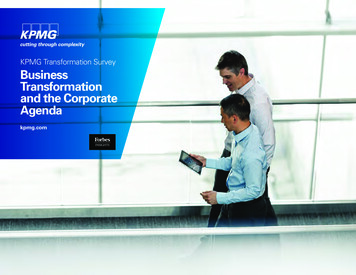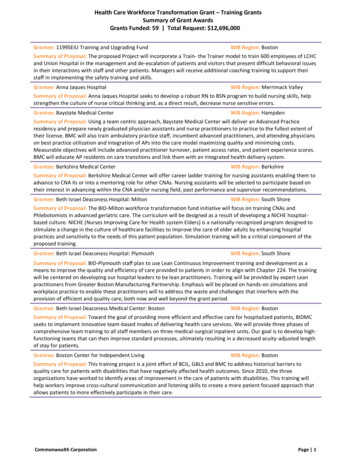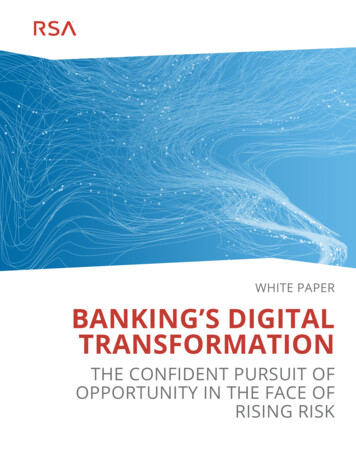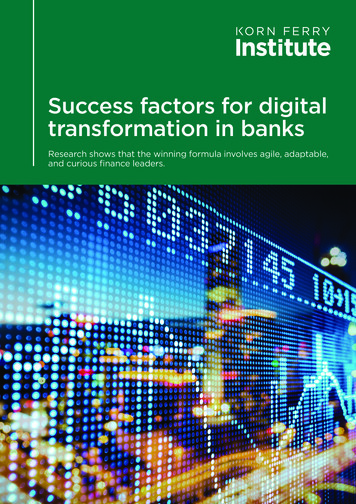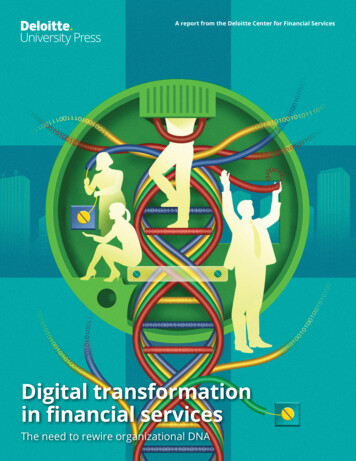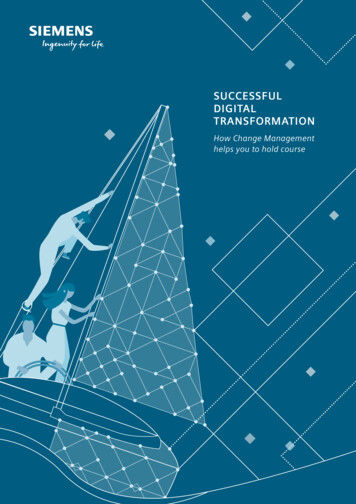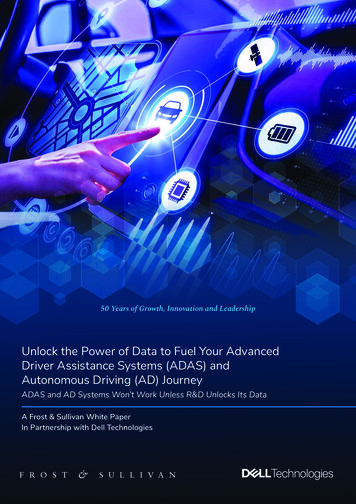
Transcription
50 Years of Growth, Innovation and LeadershipUnlock the Power of Data to Fuel Your AdvancedDriver Assistance Systems (ADAS) andAutonomous Driving (AD) JourneyADAS and AD Systems Won’t Work Unless R&D Unlocks Its DataA Frost & Sullivan White PaperIn Partnership with Dell Technologies
Unlock the Power of Data to Fuel Your Advanced Driver AssistanceSystems (ADAS) and Autonomous Driving (AD) JourneyThe automotive industry is amidst a period of transformation. A confluence of industry trends aroundsafety and emissions, customer preferences, and technology advances is shifting focus on howproducts are developed by transport and mobility industry players. Among the most visible trends isthe accelerating demand for Advanced Driver-Assistance Systems (ADAS) and Autonomous Driving(AD) systems, spurred by evolving safety standards and increased consumer interest. By 2030, 67%of vehicles sold globally will have at least level 2 and 3 autonomous driving capability. One quarter willhave level 4 and under 5% will have level 5 full automation capabilities.EXHIBIT 1: SAE LEVELS OF tomationZeroautonomy; thedriver performsall drivingtasks.Vehicle iscontrolled bythe driver, butsome drivingassist featuresmay beincluded in thevehicle design.Vehicle hascombinedautomatedfunctions, likeaccelerationand steering,but the drivermust remainengaged withthe driving taskand monitortheenvironment atall times.Driver is anecessity, butis not requiredto monitor theenvironment.The drivermust be readyto take controlof the vehicleat all timeswith notice.The vehicle iscapable ofperforming alldrivingfunctionsunder certainconditions. Thedriver mayhave the optionto control thevehicle.The vehicle iscapable ofperforming alldrivingfunctionsunder allconditions. Thedriver mayhave the optionto control thevehicle.To ensure readiness, vehicle OEMs, Tier 1 suppliers and mobility providers are reprioritizing theirinvestment in ADAS product development to fast‑track innovations to market. To do so, they mustoptimize the way they ingest and manage the massive amounts of data generated by vehicles and theinfrastructure that the current ADAS and AD test & development solutions rely on.All rights reserved 2019 Frost & Sullivan2
Unlock the Power of Data to Fuel Your Advanced Driver AssistanceSystems (ADAS) and Autonomous Driving (AD) JourneyEXHIBIT 2: CURRENT LEVEL 1 ADAS VEHICLES USE 15 –20 SENSORS ANDELECTRICAL CONTROL UNITS (ECUS), GENERATING OVER 1 TB OF DATA PER DAYLong range RADARECU & Sensor FusionAudio assistanceObstacle detectionACC Stop & GoRADAR sensorAudio assistanceReverse infoFront camerasVehicle detectionCollision avoidanceSign readingLIDARDistance & speed detectionObstacle detectionCollision avoidanceEmergency braking systemsUltrasonic sensorsParking assistParking systemsInfrared camerasPedestrian detectionNight visionSide and inside camerasBlind spot assistLane change assistDriver behaviour monitoringAs ADAS solutions evolve from simple collision-avoidance systems to fully autonomous vehicles,these systems will combine complex sensing, processing, and algorithmic technologies. Thisvehicle‑generated data is a critical component to improving ADAS systems, feeding into integratedtest and development cycles (or development tool chains) for these systems. In addition to vehiculardata, ADAS Test & Dev. systems in the next 3–5 years will also rely on inputs from infrastructure tosupport the growing scale of data movement, computing and storing required between the vehicles,across the edge, through the cloud and within on-premise environments. Such data will supportongoing modifications to current simulation, SIL, and HIL testing to improve the reliability of servicesafter deployment.3All rights reserved 2019 Frost & Sullivan
Unlock the Power of Data to Fuel Your Advanced Driver AssistanceSystems (ADAS) and Autonomous Driving (AD) JourneyHowever, before connected and autonomous vehicle providers can leverage the data, they must firstsolve the underlying complexities associated with creating data capital and value. Scaling and evolvingADAS systems will require a seamless data management process that is flexible enough to handlechallenges such as: Future-proofing ADAS simulation and architecture, to adapt to changes in vehicle sensorsand other environmental data points Managing data storage to comply with regulatory and privacy requirements, whileaddressing security and accessibility needs Analyzing massive volumes of unstructured data sets, to support analytical modelling andquerying of ADAS data. This requires costly and time-consuming data preparation steps,such as labeling data for analysis.In this report, Frost & Sullivan and Dell Technologies provide insight on how developers, engineers, anddata scientists focused on ADAS/AD development can accelerate the value of data to help their firmswin the ADAS race.WHAT MATTERS MOST TO R&DTo ensure a successful ADAS/AD approach, engineers, developers and data scientists need to prioritizeaction items. Based on conversations with these ADAS/AD leaders, Frost & Sullivan sees the followingas top initiatives:Turn driver experiences into programmable information—An integrated andhomogenized method of data storage enables developers to conduct tasks (such as localized datalabelling, transcoding, compression, and integration of data blocks) that can empower collaborativetraining, simulation and referencing of data sets. This will ensure safe operation of the vehicle into thefuture.Today our biggest bottleneck in ADAS test and devenvironment is data labelling. For some complex drivingenvironments, the time delays between data ingest andmodelling can be as much as two weeks, which we assignfor data annotation and labelling.Sr. Director, Safety and Convenience, European Tier 1 SupplierDetermine what data is and isn’t important. Develop predictive and prescriptivemodels to deal with the influx of sensory information—Labelled data will need tobe trained on predictive and prescriptive models that developers will access for each use case. Forcomplex models, users require on-demand resources to accelerate specific instances for workloads.With ADAS/AD systems now being regulated based on object sets,it is critical for developers toAll rights reserved 2019 Frost & Sullivan4
Unlock the Power of Data to Fuel Your Advanced Driver AssistanceSystems (ADAS) and Autonomous Driving (AD) Journeyprioritize models that meet all edge cases defined by safety standards, complying with the threshold offalse positives and negatives acceptable in each system.The challenge today is to understand what data sets arerelevant at what time and how much data and how manyservices will be required. We spend a significant amountof our scarce resources in object annotation and labelling,which is tedious yet critical for improving our algorithms.Chief Engineer, Fully automated driving and driver assistance PremiumEuropean OEMArchitect advanced data-driven solutions, models, statistical methods,prescriptive analytics and cognitive computing components to solve complexoperations—To minimize resource consumption, developers use dynamic computing to runvirtualization and simulation of the models. Virtual and SIL/HIL simulation is an essential step in arobust development framework for creating safety critical software. Developers prioritize compliancewith ISO 26262 and its V framework for the ADAS and AD software stack, with a diverse set ofcombinations to support statistical methods and prescriptive analytical models to ensure validity of theADAS/AD software.Key to resolving this issue and handling complex datahandling operations is to develop agile workflow modelscapable of accelerating the fine tuning of our perceptionand path planning blocks, while ensuring to adhere tostrict automotive system standards.CEO, AD Software SupplierContinuously ideate and contribute to new business services based on datacapacity and capability—Beyond development of ADAS/AD systems, the route to zero falsepositives and negatives is constantly pushing developers to create new and innovative means ofimproving ADAS/AD services. Developers are seeking more data sets from the environment andinfrastructure that can be implemented into the test and development cycle, further advancing thereliability of ADAS/AD systems.5All rights reserved 2019 Frost & Sullivan
Unlock the Power of Data to Fuel Your Advanced Driver AssistanceSystems (ADAS) and Autonomous Driving (AD) JourneyWe are now preparing for a future where in-vehiclesensors alone will not be sufficient to make ADASsystems robust enough. There will be a further influx ofdata from infrastructure and other nodes that will all needto be incorporated into our models to ensure we have anagile model for all future ADAS systems we roll out.Sr. Manager, ADAS Research & Development, European OEMUNDERSTANDING THE ADAS/AD DEVELOPMENTLIFECYCLE THAT UNDERPINS DEVELOPMENTTEAM SUCCESSIn order for vehicle OEM, Tier 1 suppliers and mobility provider development teams to leverage theirdata, they must first solve the underlying complexities associated with the ADAS/AD developmentlifecycle that will create data capital and value. Scaling and evolving ADAS and AD systems will requirea seamless test and development platform that has the capacity and flexibility handle workloadssuch as: Vehicle data acquisition, ingestion, movement and preparation of massive volumes (PBs toTBs/day) of unstructured data sets to support simulation (and ongoing re-simulation) of dataagainst ADAS/AD test cases and models. This requires costly and time-consuming datapreparation steps, such as trimming, decoding, data enrichment (labeling), processing, andadding metadata attributesDesign and development of ADAS/AD machine/deep learning models for sensor (smart cameras, lidar)and electronic control unit (ECU) system testing based on all possible corner cases, weather, and road/environment changes Re-simulations of tuned ADAS/AD models that are executed on models in the loop/hardwarein the loop/software in the loop (MiL/HiL/SiL) test systems. This involves “replaying” thecaptured raw sensor data back through the test farm—usually with hundreds or eventhousands of iterations running in parallel where high-concurrency is needed Analysis of results and ongoing support of a continuous improvement loop for the models,test cases and in-vehicle ADAS/AD sensor and ECU systems operation Archiving and managing data storage to comply with regional regulatory and contractualrequirements (simulation data restoration time), while addressing security, accessibility andaffordability needsAll rights reserved 2019 Frost & Sullivan6
Unlock the Power of Data to Fuel Your Advanced Driver AssistanceSystems (ADAS) and Autonomous Driving (AD) JourneyThese steps are not time-sequential, but must all be conducted concurrently and continuously toensure engineers, developers and data scientists within the development teams progress and createsafe and accurate models, tests and outcomes.EXHIBIT 3: DEVELOPMENT LIFECYCLE & TOOL ateBuildPerformanceSimulationValidationHardwarein the LoopSoftwarein the LoopTestDriveSources: Bosch and Frost & Sullivan.ACCELERATE AND SCALE YOUR ADAS/ADDEVELOPMENT SUCCESSThe data management and computational demands underpinning the ADAS/AD test and devenvironment are substantial and require solutions that is can accelerate time to market and scale toaccommodate complexity and exponentially growing ADAS/AD data sets. Essential to helping ADAS/AD development teams unlock the data and create value is a high performance and high capacityplatform that can provide the following:A consistent, high throughput solution to ingest data from test vehicles while simultaneouslydelivering the test data into hundreds to thousands of concurrent streams to MiL/SiL/HiL servers, teststands and even deep learning training. It must also scale performance near-linearly, so performanceisn’t degraded as capacity is added—critical for ADAS development where sensor data ingest rates of2 PB per week are becoming common.A high performance and predictable storage solution that will scale and manageADAS/AD data sets and workloads as they grow centrally and regionally. Essential elements of the7All rights reserved 2019 Frost & Sullivan
Unlock the Power of Data to Fuel Your Advanced Driver AssistanceSystems (ADAS) and Autonomous Driving (AD) Journeyplatform include an expandable single namespace, eliminating data silos by consolidating all globallycollected ADAS/AD data; automated plug and play hardware detection and expansion that won’tdisrupt ongoing projects; automated policy-based tiering to reduce file server sprawl and performancebottlenecks; and file-object orchestration and encryption that will allow data movement between highperformance network-attached storage and lower-cost private and public cloud options.Distributed deep learning frameworks are core to unlocking data capital and foundationalto ADAS and AD development. Because deep learning models are very complex and large, developerscan benefit from using a deep learning framework— an interface, library or a tool that allows them toleverage deep learning easily and quickly, without requiring in-depth understanding of the underlyingalgorithms. These frameworks provide a clear and concise way for defining models using a collectionof pre-built and pre-optimized components. Essential characteristics of well-designed deep learningframeworks, such as Tensorflow, Keras, PyTorch, and Caffe, include: optimization for GPU performance,easy to understand code, extensive community support, process parallelization to reduce computationcycles, and automatically computed gradients.An optimized and scalable accelerator-based platform that has the capacity and abilityto run AI in place as we
Unlock the Power of Data to Fuel Your Advanced k k k p' ?Ä? 3Z'[ck Ë ADAS and AD Systems Won t Work Unless R&D Unlocks Its Data
